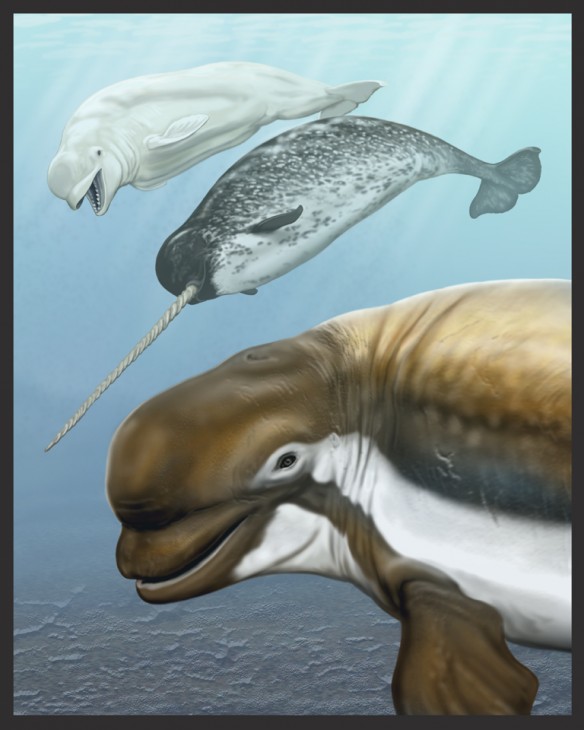A newly described species of toothed whale that lived some 3-4 million years ago during the Pliocene, is causing scientists to reconsider what is known about its living cold-water relatives: narwhals and belugas. These living marine mammals, ancient fossils show, have not always been the cold-water adapted creatures they are today, and why and when they evolved to live only in northern latitudes remains a mystery.
Bohaskaia monodontoides, as the new fossil whale is known, was recently described in a paper in the Journal of Vertebrate Paleontology by Jorge Velez-Juarbe of Howard University, who is also a Smithsonian predoctoral fellow, and Nicholas Pyenson of the Smithsonian’s National Museum of Natural History. This new species is known only from a nearly complete skull found in 1969 in a mine near Hampton, Va. Since its discovery, the skull has been housed in the paleontology collections of the Smithsonian’s National Museum of Natural History. It was loosely identified as belonging to a beluga whale but it had never been closely studied.

An artist’s conception of Bohaskaia monodontoides, foreground. Behind and above are a beluga and narwhal. (Artwork by Carl Buell)
In 2010, Velez-Juarbe and Pyenson began a close anatomical comparison of the fossil skull with the skeletons of belugas and narwhals kept in the collections of the Division of Mammals at the museum. Their study confirmed that the fossil skull was that of a new toothed whale species, one that shared features of the snout and face with belugas and narwhals. The fossil skull contained enough unique features however, to merit its placement as a new genus and species.
“Fossils referred to as belugas have been known from fragmentary bits, but skulls are so revealing because they contain so many informative features,” Pyenson says. “We realized this skull was not something assignable to a beluga, and when we sat down, comparing the fossil side by side with the actual skulls of belugas and narwhals, we found it was a very different animal.”

From left to right: Jorge Velez-Juarbe holds the skull of beluga whale; Dave Bohaska holds the skull of Bohaskaia monodontoides; and Nick Pyenson with the skull and tusk of a narwhal. They are standing in the marine mammal collections area of the Smithsonian’s National Museum of Natural History. (Photo courtesy Jorge Velez-Juarbe)
As Bohaskaia monodontoides was found in the temperate climate of Virginia, and a second extinct beluga-related toothed whale, Denebola branchycephala is known from a fossil found in Baja California, Velez-Juarbe and Pyenson surmise that the cold-climate adaptations of narwhals and beluga, which today live and breed only in the Arctic and sub-arctic, must have evolved only recently.

The fossil skull of Bohaskaia monodontoides. (Photos courtesy of Jorge Velez-Juarbe’s blog site Caribbean Paleobiology)
“The fact is that living belugas and narwhals are found only in the Arctic and subarctic, yet the early fossil record of the monodontids extends well into temperate and tropical regions,” Pyenson says. “For evidence of how and when the Arctic adaptations of belugas and narwhals arose we will have to look more recently in time.”
The change may be “related to oceanographic changes during or after the Pliocene affecting the marine food chain,” Velez-Juarbe says, “then competition or dietary preferences drove monodontids further north.”
(Bohaskaia monodontoides, was named in honor of David J. Bohaska, a museum specialist in the Department of Paleobiology at the Smithsonian’s National Museum of Natural History.)
Link to Dr. Nicholas Pyenson’s blog: https://nmnh.typepad.com/pyenson_lab/





